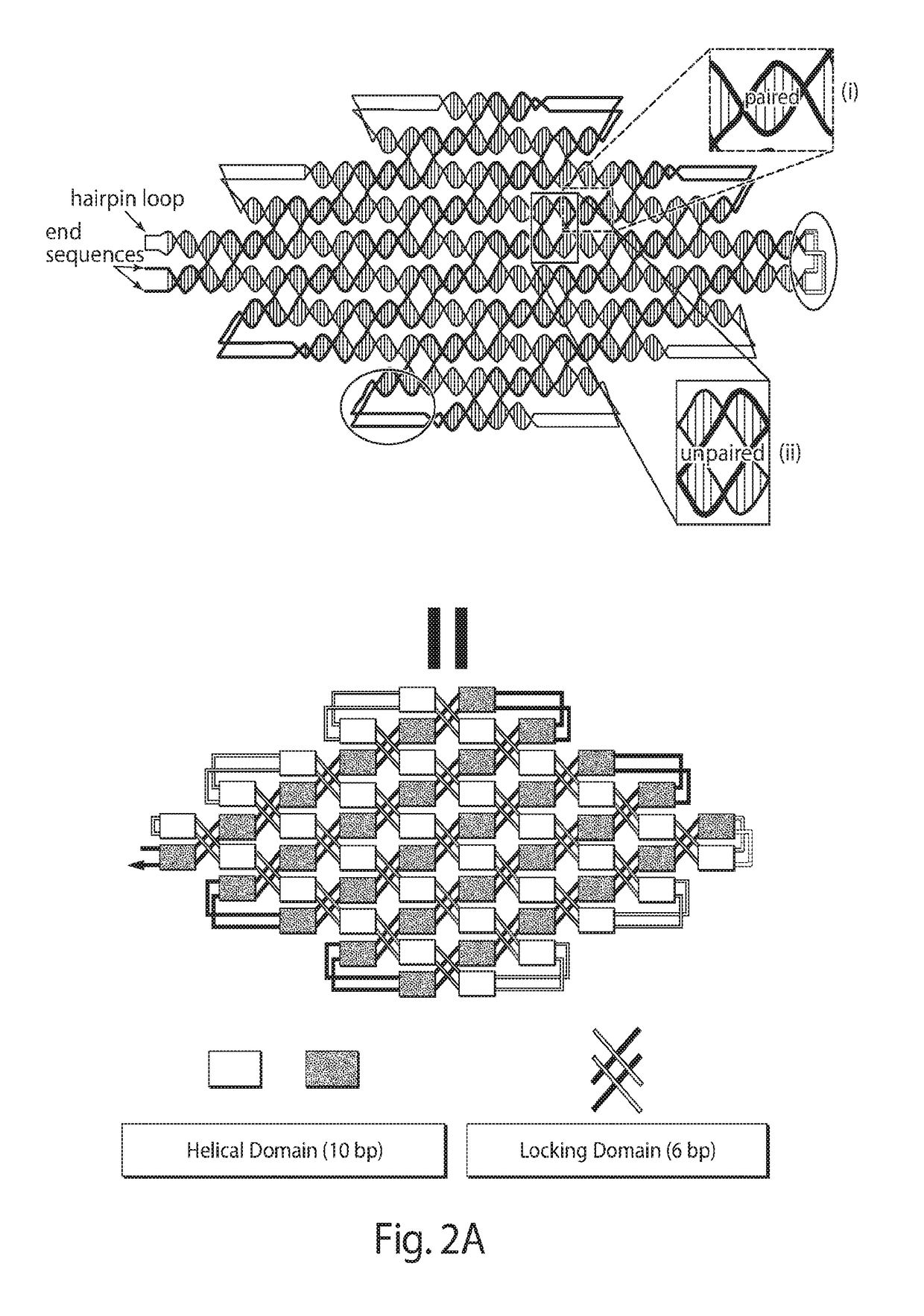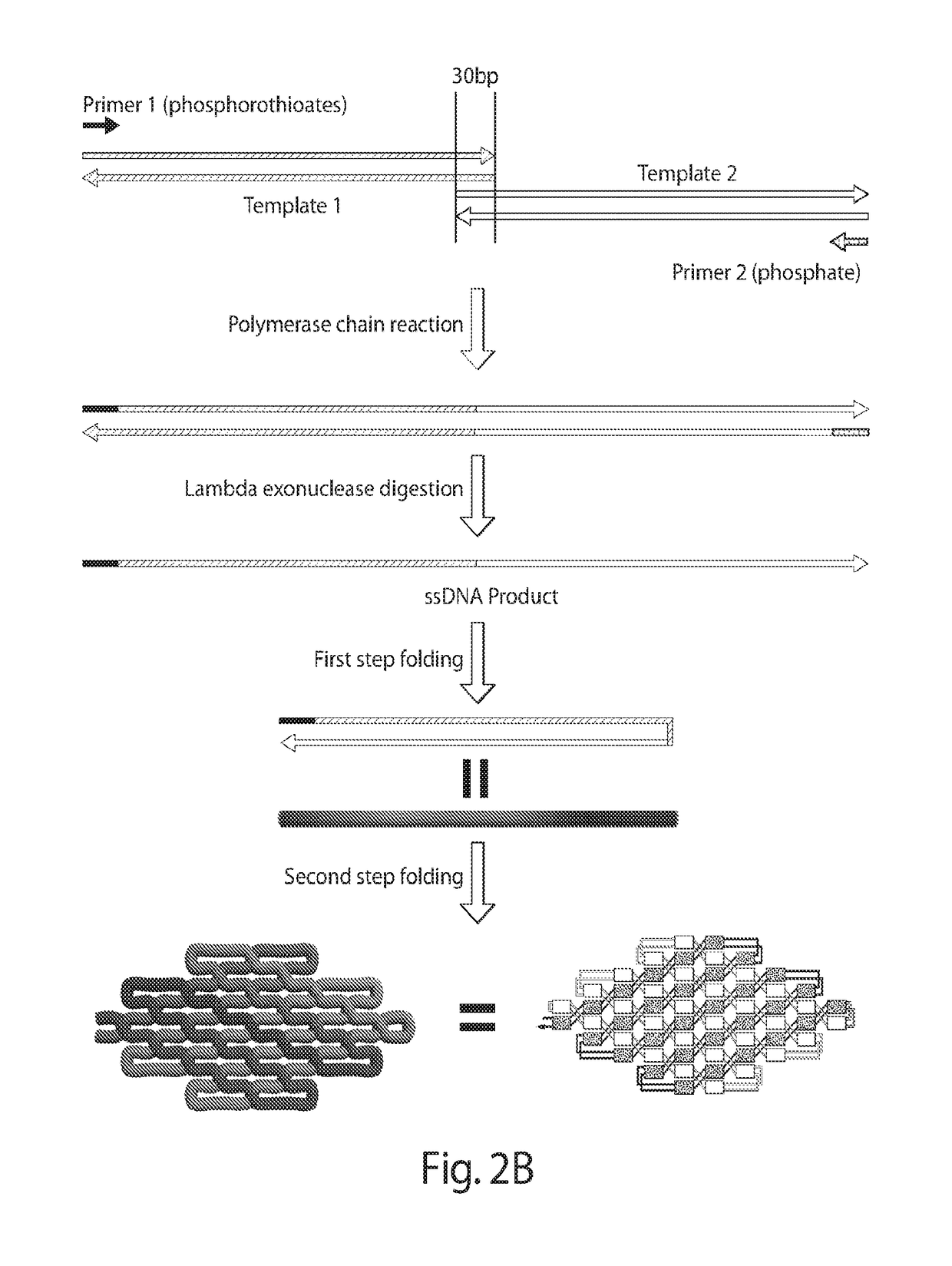Single-stranded DNA nanostructures
- Summary
- Abstract
- Description
- Claims
- Application Information
AI Technical Summary
Benefits of technology
Problems solved by technology
Method used
Image
Examples
example 1
[0158]Four different ssDNA nanostructures of the present disclosure are shown in FIGS. 3A-3D. Three-dimensional (3D) models indicating helical and locking domains are depicted in the top panels; 3D models showing the track of partially formed double strand intermediates are depicted in the middle panels; and atomic force microscopy (AFM) images are depicted in the bottom panels. FIG. 3A depicts is a diamond-shape structure, which contains 2170 nucleotides. The double-strand intermediate starts from the left side of the design in the cylinder model. It folds back and forth in a raster-filling pattern on the back of the design and goes to the top layer, starting from the vertex on the right of the model. FIG. 3B depicts a triangle-shape structure (3547 nt) with three arms that self-assemble independently. The starting and ending points of the track are both in the bottom arm of the triangle, and the double-strand intermediate travels between the bottom layer and the top layer several ...
example 2
[0160]Single-stranded DNA nanostructures having different sizes were assembled and are shown in FIGS. 4A-4C. Three diamond shape nanostructures containing 1 k, 1.6 k and 2.3 k nucleotides (nt) are shown and were obtained with high yield.
[0161]A two-layer design strategy can be applied to diamond-shaped ssDNA nanostructures with variable sizes. Based on the number of pipeline sections in the two layers, m×n ssDNA nanostructures have been created successfully (m denotes the number of diagonally oriented, partially-paired helices in the top layer and n denotes number of partially-paired helices in the bottom layer) such as the 3×3, 4×4 and 5×5 ssDNA nanostructures of the present disclosure which are shown in FIGS. 4A-4C. For example, the 3×3 structure (FIG. 4A) contains 9 locking domains in the design and the 5×5 structure (FIG. 4C) contains 25 locking domains. When all the locking domains are correctly paired in the folding process, a well-folded ssDNA nanostructure is produced. FIGS....
example 3
[0162]ssDNA nanostructures are designed to contain single-stranded loops, for example, protruding from arbitrary positions on the structure. FIG. 5A illustrates an example of six-loop design based on a diamond-shape ssDNA nanostructure (top and middle panels) and attachment of heterogeneous elements, such as fluorescent dye molecules and protein structures (bottom panel). Based on this design, DNA-PAINT (points accumulation for imaging in nanoscale topography) is used to demonstrate the accurate arrangement capability of ssDNA nanostructures (FIG. 5B, top panel). FIG. 5B, bottom panel, shows reversible specific binding of fluorescently labeled nucleic acid being used to perform optical imaging with ˜5 nm resolution on a nucleic acid nanostructures assembled from multiple strands of DNA. Note that one or more labeled points are missing, indicative of missing strands and local defects in such heterogeneous structures.
PUM
| Property | Measurement | Unit |
|---|---|---|
| Temperature | aaaaa | aaaaa |
| Temperature | aaaaa | aaaaa |
| Temperature | aaaaa | aaaaa |
Abstract
Description
Claims
Application Information
 Login to View More
Login to View More - R&D
- Intellectual Property
- Life Sciences
- Materials
- Tech Scout
- Unparalleled Data Quality
- Higher Quality Content
- 60% Fewer Hallucinations
Browse by: Latest US Patents, China's latest patents, Technical Efficacy Thesaurus, Application Domain, Technology Topic, Popular Technical Reports.
© 2025 PatSnap. All rights reserved.Legal|Privacy policy|Modern Slavery Act Transparency Statement|Sitemap|About US| Contact US: help@patsnap.com



